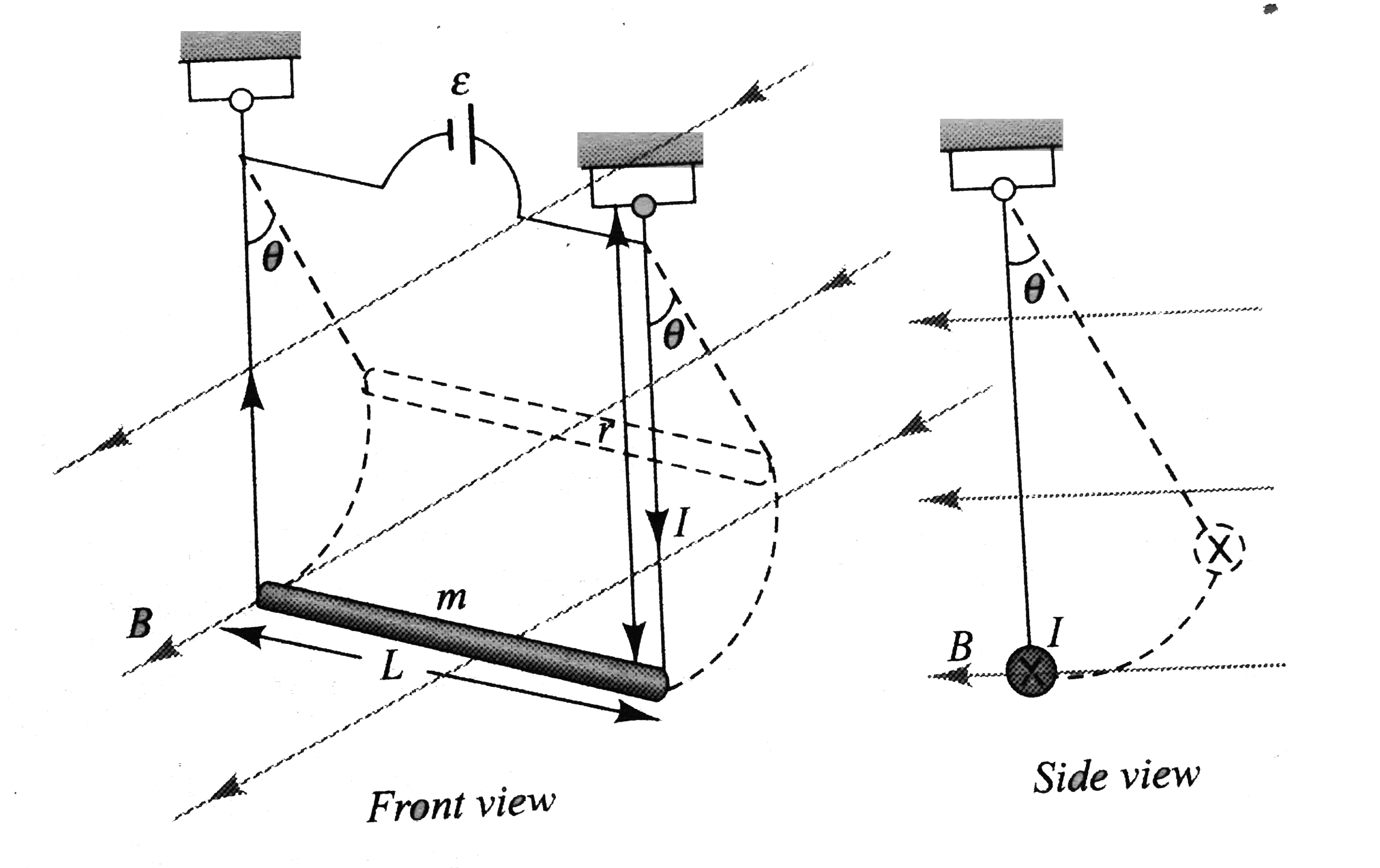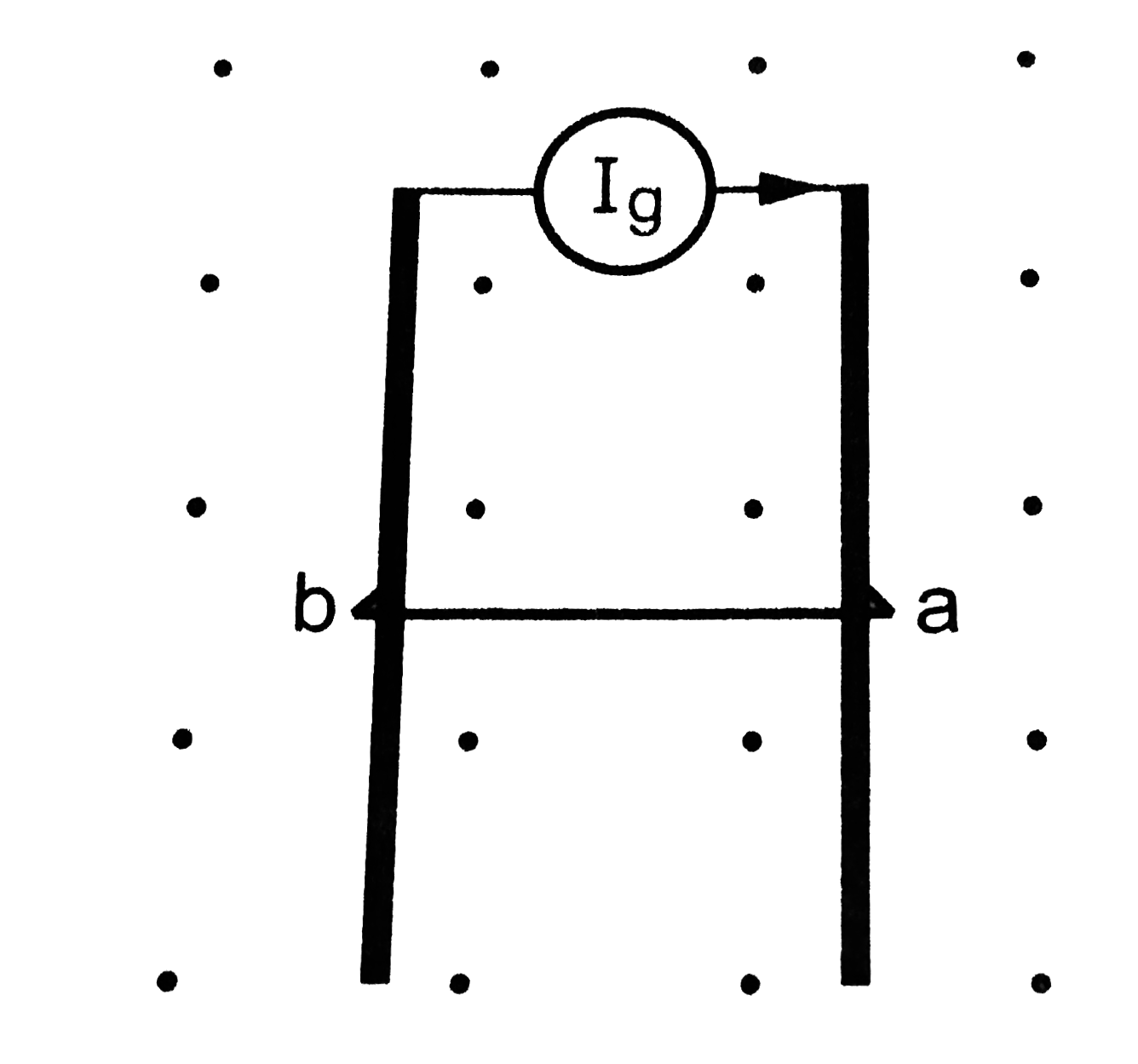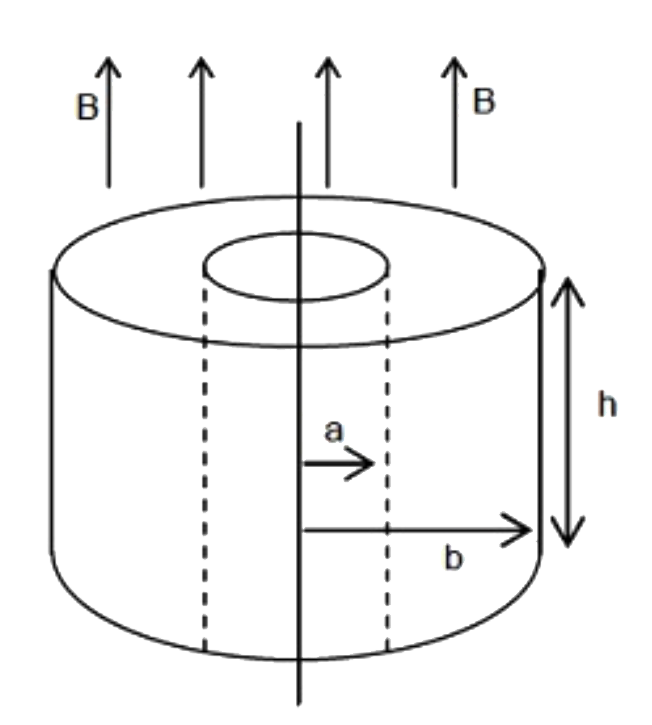A pivoted aluminium bar falls much more slowly through a small region containing a magnetic field then a similar bar of an insulating material. Explain.
To understand why a pivoted aluminum bar falls much more slowly through a magnetic field compared to a similar bar made of insulating material, we need to analyze the concepts of electromagnetic induction and eddy currents.
1. Understanding the Setup:
- We have two bars: one made of aluminum (a conductor) and the other made of an insulating material (like plastic).
- Both bars are pivoted and are allowed to fall through a region where there is a magnetic field.
2. Magnetic Field Interaction:
- When the aluminum bar falls through the magnetic field, it experiences a change in magnetic flux. According to Faraday's law of electromagnetic induction, this change induces an electromotive force (EMF) in the bar.
3. Eddy Currents Formation:
- The induced EMF causes circulating currents known as eddy currents to flow within the aluminum bar. These currents flow in loops within the material and create their own magnetic fields.
4. Opposition to Motion:
- According to Lenz's law, the direction of the induced eddy currents is such that they oppose the change that created them. In this case, the eddy currents oppose the motion of the falling aluminum bar, resulting in a magnetic drag force acting upwards.
5. Conversion of Energy:
- As the aluminum bar falls, the kinetic energy of the bar is converted into thermal energy due to the resistance encountered by the eddy currents. This conversion leads to a decrease in the kinetic energy of the bar.
6. Slower Fall of Aluminum Bar:
- Due to the opposing force from the eddy currents, the aluminum bar falls more slowly than it would in the absence of the magnetic field. The increase in thermal energy also results in a reduction of the bar's velocity over time.
7. Insulating Bar Behavior:
- In contrast, the insulating bar does not conduct electricity, and therefore no eddy currents are induced when it falls through the magnetic field. As a result, it does not experience any opposing force due to magnetic drag and falls at a normal rate, unaffected by the magnetic field.
Conclusion:
The aluminum bar falls more slowly through the magnetic field because the induced eddy currents create a magnetic drag force that opposes its motion, converting kinetic energy into thermal energy. The insulating bar, lacking conductivity, does not experience this effect.
- We have two bars: one made of aluminum (a conductor) and the other made of an insulating material (like plastic).
- Both bars are pivoted and are allowed to fall through a region where there is a magnetic field.
- When the aluminum bar falls through the magnetic field, it experiences a change in magnetic flux. According to Faraday's law of electromagnetic induction, this change induces an electromotive force (EMF) in the bar.
- The induced EMF causes circulating currents known as eddy currents to flow within the aluminum bar. These currents flow in loops within the material and create their own magnetic fields.
- According to Lenz's law, the direction of the induced eddy currents is such that they oppose the change that created them. In this case, the eddy currents oppose the motion of the falling aluminum bar, resulting in a magnetic drag force acting upwards.
- As the aluminum bar falls, the kinetic energy of the bar is converted into thermal energy due to the resistance encountered by the eddy currents. This conversion leads to a decrease in the kinetic energy of the bar.
- Due to the opposing force from the eddy currents, the aluminum bar falls more slowly than it would in the absence of the magnetic field. The increase in thermal energy also results in a reduction of the bar's velocity over time.
- In contrast, the insulating bar does not conduct electricity, and therefore no eddy currents are induced when it falls through the magnetic field. As a result, it does not experience any opposing force due to magnetic drag and falls at a normal rate, unaffected by the magnetic field.
The aluminum bar falls more slowly through the magnetic field because the induced eddy currents create a magnetic drag force that opposes its motion, converting kinetic energy into thermal energy. The insulating bar, lacking conductivity, does not experience this effect.
Topper's Solved these Questions
- ELECTROMAGNETIC INDUCTIONBOOK - HC VERMA ENGLISHCHAPTER - ELECTROMAGNETIC INDUCTIONEXERCISE - EXERCISE
98 Videos
- ELECTRIC FIELD AND POTENTIALBOOK - HC VERMA ENGLISHCHAPTER - ELECTRIC FIELD AND POTENTIALEXERCISE - Objective 2
7 Videos
- ELECTROMAGNETIC WAVESBOOK - HC VERMA ENGLISHCHAPTER - ELECTROMAGNETIC WAVESEXERCISE - Exercise
8 Videos
Similar Questions
An iron bar falling vertically through the hollow region of a thick cylindrical shell made of copper experiences a retarding force and attains a terminal velocity. What can you conclude about the iron bar?
View SolutionIn a trapeze-shaped structure, two rigid wires of negligble mass support a conducting bar of mass m and length L as shown in Fig. A source of emf is applied to the wires so that a current I flows through the bar. A uniform magnetic field →B is perpendicular to the plane of the wires and bar.
a. Compute the current that the source of emf must provide so that there is no tension in the wires.
b. If the current is reduced to half the value computed in (a) and the plane of the structure is moved through an angle θ, compute the tension in the wires and the magnitude of the net unbalanced force on the bar at the instant it is released from this angle.

View SolutionThe system containing the rails and the wire of the previous problem is kept vertically in a uniform horizontal magnetic field B that is perpendicular to the plane of the rails. It is found that the wire stays in equilibrium. If the wire ab is replaced by another of double its mass, how long will it take in falling through a distance equal ot its length?

View SolutionA charged particle of specific charge s moves undeflected through a region of space containing mutually perpendicular and uniform electric and magnetic fields, E and B. When the field E is switched off, the particle will move in a circular path of radius
View SolutionA charged particle of specific charge s moves undeflected through a region of space containing mutually perpendicular and uniform electric and magnetic fields, E and B. When the field E is switched off, the particle will move in a circular path of radius
View SolutionA conducting ring of circular cross - section with inner and outer radii a and b is made out of a material of resistivity ρ. The thickness of the ring is h. It is placed coaxially in a vertical cylindrical region of a magnetic field B=krt. Where k is a positive constant, r is the distance from the axis and t is the time. If the current through the ring is I=(khαp)[b3−a3] , then what is the value of α?

View Solution(a) A rod of length l is moved horizontal with a uniform velocity v in a direction perendicular to its length through a region in which a uniform magnetic field is acting vertically downward. Derive the expression for the emf induced across the end of the rod.
(b) How does one understand this motional emf by invoking the Lorentz force acting on the free charge carriers of the conductor? Explain.
View SolutionThe existence of negatively charged particle in an atom was shown by J.J. Thomson as a result of the studies of the passage of electricity through gases at extremely low pressure known as discharge tube experiments. When a high voltage of the order of 10,000 volts or more was impressed across the electrodes, some sort of invisible rays moved from the negative electrode to the positive electrode these rays are called as cathode rays.

Cathode rays travel in straight path in absence of electrical and magnetic field . Cathode rays consist of material part and charged particles? Cathode rays produce X-rays and light is emitted when they strike on ZnS screen. Cathode rays penetrate through thin sheets of aluminium and other metals . They affect the photogenic plate and passes heating effect when they strike on metal foil. The raito of charge to mass i.e charge/mass is same for all the cathode rays irrespective of the gas used in the tube.
The existence of positively charged particle in an atom was shown be E. Goldstein. He repeated the same discharge tube experiments by using a perforated cathode. It was observed that when a high potential difference was applied between the electrodes, not only cathode rays were produced but also a new type of rays were produced simultaneoulsy from anode moving towards cathode and passes through the holes or canal of the cathode. These termed as canal rays or anode rays.
These rays travel in straight lines and consists of positively charged particles. These rays have kinetic energy and produces heating effect also. The e/m ratio of these rays is smaller than that of electrons. Unlike cathode rays, their e/m value is dependent upon the nature of the gas taken in the tube. These rays produced flashes of light on ZnS screen and can pass throughs thin metal foils. They can produce physical and chemical changes and are capable to produce ionisation in gases.
Which is not true with respect to cathode rays?
View SolutionThe existence of negatively charged particle in an atom was shown by J.J. Thomson as a result of the studies of the passage of electricity through gases at extremely low pressure known as discharge tube experiments. When a high voltage of the order of 10,000 volts or more was impressed across the electrodes, some sort of invisible rays moved from the negative electrode to the positive electrode these rays are called as cathode rays.

Cathode rays travel in straight path in absence of electrical and magnetic field . Cathode rays consist of material part and charged particles? Cathode rays produce X-rays and light is emitted when they strike on ZnS screen. Cathode rays penetrate through thin sheets of aluminium and other metals . They affect the photogenic plate and passes heating effect when they strike on metal foil. The raito of charge to mass i.e charge/mass is same for all the cathode rays irrespective of the gas used in the tube.
The existence of positively charged particle in an atom was shown be E. Goldstein. He repeated the same discharge tube experiments by using a perforated cathode. It was observed that when a high potential difference was applied between the electrodes, not only cathode rays were produced but also a new type of rays were produced simultaneoulsy from anode moving towards cathode and passes through the holes or canal of the cathode. These termed as canal rays or anode rays.
These rays travel in straight lines and consists of positively charged particles. These rays have kinetic energy and produces heating effect also. The e/m ratio of these rays is smaller than that of electrons. Unlike cathode rays, their e/m value is dependent upon the nature of the gas taken in the tube. These rays produced flashes of light on ZnS screen and can pass throughs thin metal foils. They can produce physical and chemical changes and are capable to produce ionisation in gases.
Select the incorrect statement.
View SolutionThe existence of negatively charged particle in an atom was shown by J.J. Thomson as a result of the studies of the passage of electricity through gases at extremely low pressure known as discharge tube experiments. When a high voltage of the order of 10,000 volts or more was impressed across the electrodes, some sort of invisible rays moved from the negative electrode to the positive electrode these rays are called as cathode rays.

Cathode rays travel in straight path in absence of electrical and magnetic field . Cathode rays consist of material part and charged particles? Cathode rays produce X-rays and light is emitted when they strike on ZnS screen. Cathode rays penetrate through thin sheets of aluminium and other metals . They affect the photogenic plate and passes heating effect when they strike on metal foil. The raito of charge to mass i.e charge/mass is same for all the cathode rays irrespective of the gas used in the tube.
The existence of positively charged particle in an atom was shown be E. Goldstein. He repeated the same discharge tube experiments by using a perforated cathode. It was observed that when a high potential difference was applied between the electrodes, not only cathode rays were produced but also a new type of rays were produced simultaneoulsy from anode moving towards cathode and passes through the holes or canal of the cathode. These termed as canal rays or anode rays.
These rays travel in straight lines and consists of positively charged particles. These rays have kinetic energy and produces heating effect also. The e/m ratio of these rays is smaller than that of electrons. Unlike cathode rays, their e/m value is dependent upon the nature of the gas taken in the tube. These rays produced flashes of light on ZnS screen and can pass throughs thin metal foils. They can produce physical and chemical changes and are capable to produce ionisation in gases.
For cathode rays the value of e/m:
View Solution
